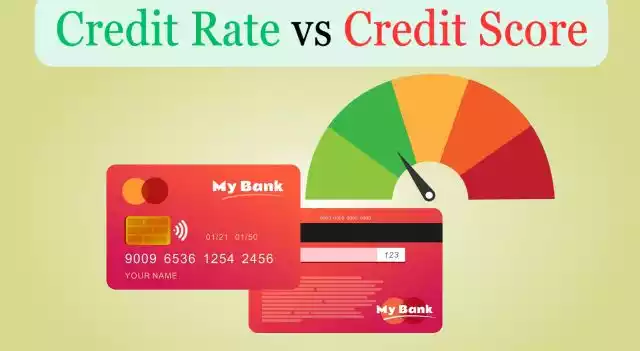In the complex world of finance, terms like “credit rating” and “credit score” are often used interchangeably, leading to confusion among consumers. However, these two concepts play distinct roles in determining an individual’s or a company’s creditworthiness. In this comprehensive guide, we will delve into the nuances of credit rating and credit score, unraveling the difference between credit rating and credit score.
What is Credit Ratings?
Credit ratings stand as crucial indicators of an individual’s or an entity’s creditworthiness. These letter grades, ranging from AAA to D, encapsulate an assessment of the borrower’s ability to repay their debts in a timely manner. Credit ratings play a pivotal role in various financial decisions, influencing loan approvals, interest rates, and overall access to credit.
Significance of Credit Ratings
Credit ratings are assigned by credit rating agencies, independent organizations that evaluate the creditworthiness of borrowers. These agencies, such as Credit Rating Information Services of India Ltd. (CRISIL), Investment Information and Credit Rating Agency of India (ICRA) Ltd., Credit Analysis and Research (CARE) Ltd., Brickwork Ratings India Private Ltd., etc. employ rigorous analytical methods to assess a borrower’s financial strength, debt obligations, and overall risk profile.
Credit Rating Scale
Credit ratings are typically expressed on a letter grade scale, with AAA denoting the highest creditworthiness and D signifying the lowest. The scale can be further divided into investment-grade and non-investment-grade ratings. Investment-grade ratings, ranging from AAA to BBB, indicate a lower credit risk and are considered relatively safe investments. Non-investment-grade ratings, encompassing BB+ to D, signal a higher credit risk and carry a greater likelihood of default.
Factors Influencing Credit Ratings
A multitude of factors influence credit ratings, including:
- Debt-to-Income Ratio (DTI): The proportion of a borrower’s debt to their income. A high DTI indicates a greater financial strain and could negatively impact a credit rating.
- Payment History: A consistent record of timely debt repayments demonstrates creditworthiness and positively influences credit ratings.
- Credit Utilization Ratio: The percentage of available credit that a borrower is using. A high credit utilization ratio suggests overreliance on credit and could lower credit ratings.
- Length of Credit History: A longer credit history provides more data for credit rating agencies to assess a borrower’s financial behavior and creditworthiness.
- Type of Credit: Different types of credit carry varying risks. Secured loans, backed by collateral, are generally considered less risky than unsecured loans.
Impact of Credit Ratings on Financial Life
Credit ratings have a profound impact on an individual’s or entity’s financial life:
- Loan Approvals and Interest Rates: Higher credit ratings increase the likelihood of loan approvals and often secure lower interest rates.
- Insurance Premiums: Credit ratings can influence insurance premiums, with lower credit ratings potentially leading to higher premiums.
- Access to Credit: Favorable credit ratings open doors to a wider range of credit options, including mortgages, car loans, and credit cards.
Credit ratings serve as valuable tools for assessing creditworthiness and guiding financial decisions. By understanding credit ratings and implementing responsible financial practices, individuals and entities can pave the way for a more secure and stable financial future.
What is Credit Score?
Credit scores stand as crucial indicators of an individual’s financial credibility. These three-digit numbers, ranging from 300 to 850, serve as a condensed representation of a person’s creditworthiness, influencing their ability to secure loans, obtain favorable interest rates, and navigate the financial landscape with ease.
Fundamentals of Credit Score
Credit scores are meticulously calculated by credit bureaus, independent organizations that compile and analyze credit information. These bureaus, such as Equifax, Experian, and TransUnion, employ sophisticated algorithms to assess various aspects of a person’s credit history, including payment history, credit utilization, length of credit history, types of credit, and recent credit inquiries.
Factors Influencing Credit Scores
A multitude of factors contribute to shaping an individual’s credit score:
- Payment History: A consistent track record of timely debt repayments is the cornerstone of a good credit score.
- Credit Utilization Ratio (CUR): The percentage of available credit that is being utilized significantly impacts credit scores. A lower CUR indicates responsible credit management.
- Length of Credit History: An extensive credit history provides credit bureaus with more data to evaluate an individual’s creditworthiness.
- Types of Credit: Maintaining a diverse credit portfolio, including both secured and unsecured loans, demonstrates responsible credit usage.
- Recent Credit Inquiries: Hard inquiries, which occur when lenders access your credit report for loan applications, can temporarily lower your credit score.
Impact of Credit Score
Credit scores have a profound influence on various aspects of an individual’s financial life:
- Loan Applications and Interest Rates: Favorable credit scores increase the likelihood of loan approvals and often secure lower interest rates.
- Insurance Premiums: Credit scores can influence insurance premiums, with lower credit ratings potentially leading to higher premiums.
- Rental Opportunities: Landlords often consider credit scores when evaluating rental applications.
- Employment Prospects: In certain industries, employers may review credit scores as part of the hiring process.
Embracing Credit Scores for Financial Empowerment
Credit scores serve as valuable tools for assessing creditworthiness and navigating the financial landscape. By understanding credit scores and implementing responsible financial practices, individuals can empower themselves to achieve financial stability and pave the way for a brighter financial future.
Additional Tips for Maintaining a Healthy Credit Score:
- Avoid opening too many new credit accounts in a short period.
- Pay off debts in full whenever possible.
- Be mindful of co-signing loans, as you become responsible for the debt if the primary borrower defaults.
- Educate yourself about credit scores and the factors that affect them.
- Consider using a credit monitoring service to stay informed about your credit score and report.
Difference between Credit Rating and Credit Score

Key Differences between Credit Rating vs. Credit Score
The following table summarizes the key differences between credit rating and credit score:
| Feature | Credit Rating | Credit Score |
| Purpose | Assess creditworthiness of businesses and governments | Assess creditworthiness of individuals |
| Expression | Letter grades | Numerical value |
| Issuers | Credit rating agencies | Credit bureaus |
| Users | Investors | Lenders |
| Typical Range | AAA to D | 300 to 850 |
Let us discuss the main Differences between Credit Rating and Credit Score.
1. Definition:
Credit Rating:
A credit rating is an evaluation assigned by credit rating agencies to assess the creditworthiness of a company or government. This evaluation is based on an in-depth analysis of financial records, payment history, and other relevant economic indicators. Credit ratings are crucial for investors and lenders as they provide insights into the risk associated with lending money to a particular entity.
Credit Score:
On the other hand, a credit score is a numeric representation of an individual’s creditworthiness. It is generated by credit bureaus using a proprietary algorithm that considers factors such as payment history, credit utilization, length of credit history, types of credit, and new credit. Credit scores are essential for individuals seeking loans, as they influence the interest rates and terms they may be offered.
2. Purpose:
Credit Rating:
The primary purpose of a credit rating is to assist investors and lenders in making informed decisions about investing in bonds, securities, or providing loans to entities. It helps them gauge the likelihood of the borrower defaulting on their financial obligations.
Credit Score:
A credit score, on the other hand, is a tool for lenders to assess the risk of lending money to an individual. It is commonly used by banks, credit card companies, and other financial institutions when determining eligibility for loans and setting interest rates.
3. Scale and Interpretation:
Credit Rating:
Credit ratings typically use letter grades or a numerical scale. For example, Standard & Poor’s and Moody’s use letter grades ranging from AAA (highest credit quality) to D (default). A higher credit rating indicates lower credit risk.
Credit Score:
Credit scores commonly range from 300 to 850, with higher scores indicating better creditworthiness. FICO scores, one of the most widely used credit scoring models, categorize scores into ranges such as Poor (300-579), Fair (580-669), Good (670-739), Very Good (740-799), and Excellent (800-850).
4. Scope of Application:
Credit Rating:
Credit ratings are typically applied to corporations, municipalities, and governments. Investors use these ratings to assess the risk associated with specific financial instruments, such as bonds or securities.
Credit Score:
Credit scores are individual-centric and are used for various purposes, including mortgage approvals, credit card applications, and determining interest rates on loans. Landlords and employers may also consider credit scores during rental or employment evaluations.
5. Frequency of Updates:
Credit Rating:
Credit ratings are not frequently updated and may remain unchanged for an extended period, sometimes months or even years, unless there are significant financial events impacting the entity.
Credit Score:
Credit scores are more dynamic and can change frequently, reflecting an individual’s current financial behavior. Factors such as timely payments, new credit applications, or increased credit card balances can influence credit scores.
How to Improve Credit Ratings or Credit Reports?
Improving credit ratings or credit reports requires disciplined financial management:
- Make Timely Payments: Timely debt repayments are paramount for maintaining positive credit history.
- Keep Credit Utilization Low: Avoid maxing out credit cards and maintain a low credit utilization ratio.
- Monitor Credit Reports Regularly: Regularly review credit reports to identify and address any errors or discrepancies.
- Diversify Credit Types: Maintain a mix of credit types, including secured and unsecured loans, to demonstrate responsible credit usage.
- Seek Professional Guidance: If facing credit challenges, consider consulting a credit counselor for personalized advice.
End Note on Difference between Credit Rating and Credit Score
In conclusion, while credit ratings and credit scores both assess creditworthiness, they operate on different scales, serve distinct purposes, and cater to different entities. Understanding these differences empowers consumers, investors, and lenders alike to navigate the intricate landscape of credit with greater clarity. Whether you’re a company seeking investment or an individual applying for a loan, comprehending the nuances between credit ratings and credit scores is paramount in making informed financial decisions.
Difference between Credit Rating and Credit Score – Related FAQs
What is Credit Score?
A credit score is a numerical representation of an individual’s creditworthiness, derived from a comprehensive analysis of their credit history.
What is Credit Rating?
A credit rating is a comprehensive assessment of a prospective debtor’s (an individual, business, company, or government) creditworthiness, predicting their ability to repay their debt and providing an implicit forecast of the likelihood of default.
What is a good credit score?
Here is a breakdown of credit score ranges:
300-669: Fair
670-739: Good
740-799: Very good
800-850: Excellent
.

